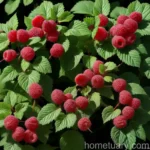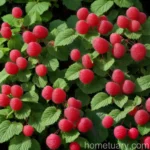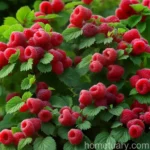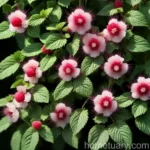Plant Scientist Blog: All About Raspberry (Rubus idaeus ‘Prelude’)
Raspberry (Rubus idaeus ‘Prelude’) is a popular fruit-bearing plant known for its delicious, vibrant berries and relatively easy cultivation. In this comprehensive guide, we will explore the various aspects of growing and caring for raspberry plants, including their culture, uses, maintenance, common diseases, pests, and much more. Whether you are a beginner or an experienced gardener, this article aims to provide valuable insights into the world of raspberry cultivation.
What is Raspberry (Rubus idaeus ‘Prelude’)?
Before delving into the specific details of raspberry cultivation, it’s essential to understand the basic characteristics of the plant. Raspberry (Rubus idaeus) is a deciduous perennial that belongs to the rose family (Rosaceae). The ‘Prelude’ variety, in particular, is prized for its early fruiting, making it a sought-after choice for gardeners keen on enjoying an early raspberry harvest.
Key Takeaways – Raspberry (Rubus idaeus ‘Prelude’)
Let’s begin by summarizing the key takeaways about raspberry (Rubus idaeus ‘Prelude’).
-
Cultivation: Raspberry plant cultivation requires attention to details such as soil type, pruning techniques, and appropriate fertilization for optimal growth and fruit production.
-
Uses: The berries of the raspberry plant are widely used for fresh consumption, jams, jellies, sauces, desserts, and beverages.
-
Water: Proper irrigation is crucial for raspberry plants, as they require consistent moisture, especially during the fruiting season.
-
Sunlight: Raspberry plants thrive in full to partial sunlight, making it essential to choose an appropriate location for planting.
-
Fertilizer: Providing the right balance of nutrients is vital for the healthy development of raspberry plants and the production of flavorful berries.
-
Soil: Good soil drainage and rich, loamy soil are ideal for raspberry cultivation, ensuring that the plants receive adequate aeration and nutrients.
-
Pruning: Pruning techniques play a significant role in maintaining the health and productivity of raspberry plants, removing old canes and encouraging new growth.
-
Propagation: Raspberry plants can be propagated through various methods, including division, cuttings, and suckers.
-
Container: Growing raspberries in containers is a viable option for gardeners with limited space, provided that the necessary care requirements are met.
-
Popularity: The popularity of raspberry plants is evident, with an increasing number of individuals growing them in home gardens and larger agricultural settings.
In the following sections, we will dive deeper into each of these aspects and provide detailed insights to aid in successful raspberry cultivation.
Culture
Cultivating raspberry plants involves understanding their specific needs and providing the appropriate care to ensure healthy growth and bountiful harvests.
Soil Requirements for Growing Raspberries
Raspberry plants thrive in well-drained, fertile, and slightly acidic soil with a pH level between 5.5 and 6.5. Additionally, the soil should be rich in organic matter to provide essential nutrients and promote vigorous growth.
Sunlight and Water Needs for Raspberry Plants
Raspberry plants prefer full sun exposure, which translates to a minimum of 6–8 hours of direct sunlight daily. Adequate sunlight is essential for optimizing fruit production and ensuring the development of flavorful berries. When it comes to water, raspberry plants require consistent moisture, especially during the fruiting period, to support the growth and juiciness of the berries.
Fertilizing Rubus idaeus ‘Prelude’
Fertilizing raspberry plants is crucial for maintaining their overall health and vigor. A balanced fertilizer, such as a 10-10-10 NPK (nitrogen, phosphorus, and potassium) blend, can be applied in the early spring before new growth emerges. Additional applications may be beneficial after the fruiting season to support the plant’s ongoing nutritional needs.
Pruning Techniques for Raspberry Plants
Pruning raspberry plants is essential to promote fruiting, manage plant size, and remove diseased or damaged canes. Proper pruning techniques involve removing spent canes post-harvest, thinning canes to improve airflow and light penetration, and training the remaining canes to trellises or support systems for better fruit development.
Raspberry Plant Propagation
Raspberry plants can be propagated through various methods, including division, cuttings, and the use of suckers. Each propagation technique offers unique advantages for expanding raspberry plantings and ensuring continued berry production.
Raspberry Plant Spacing
When planting raspberry bushes, proper spacing is important to allow for adequate airflow, sunlight penetration, and future growth. Typical spacing for raspberry plants is between 2–3 feet apart within rows, with 8–10 feet between rows to facilitate maintenance and harvesting.
Mulching Techniques for Raspberry Beds
Mulching raspberry beds with organic materials, such as straw or wood chips, helps regulate soil moisture, suppress weed growth, and protect the shallow roots of the plants. Mulch also contributes to an even soil temperature, which can benefit the overall health and productivity of the raspberry plants.
Uses
Raspberry plants offer a versatile range of uses, from fresh consumption to culinary applications and preservation for future enjoyment.
Harvesting Rubus idaeus ‘Prelude’ Berries
The ‘Prelude’ variety of raspberry is known for its early fruiting, allowing gardeners to enjoy a delectable harvest in the early summer months. When the berries reach a deep red color and easily detach from the plant with a gentle tug, they are ready for picking. Harvesting should be undertaken regularly to ensure the continuous production of ripe, flavorful berries.
Raspberry Plant Companion Planting
Companion planting with raspberry bushes can provide several benefits, including improved pollination, pest control, and efficient use of garden space. Suitable companion plants include aromatic herbs, such as thyme and oregano, as well as flowering plants that attract beneficial insects like bees and ladybugs.
Best Companion Plants for Rubus idaeus ‘Prelude’
When choosing companion plants for the ‘Prelude’ variety of raspberry, consider options that complement its growth and development. Plants that support the overall health of the raspberry bushes and promote a balanced ecosystem are valuable additions to the garden.
Maintenance
To ensure the optimal growth and productivity of raspberry plants, certain maintenance practices need to be carried out at appropriate times throughout the growing season.
Disease Diagnosis
Regular monitoring of raspberry plants for symptoms of common diseases, such as powdery mildew and anthracnose, is essential for early diagnosis and prompt treatment. Identifying potential issues at the onset can prevent the spread of diseases and minimize their impact on plant health.
Common Diseases
Raspberry plants are susceptible to various diseases that can potentially affect their vigor and fruit production. Understanding the symptoms and preventive measures for common diseases is vital for maintaining the overall health of the plants.
Disease Prevention and Control
Implementing preventive measures, such as proper sanitation, choosing disease-resistant varieties, and maintaining optimum growing conditions, is key to minimizing the risk of diseases in raspberry plants. Additionally, timely intervention through organic or conventional treatments can help manage existing issues effectively.
Common Pests
Raspberry plants can be targeted by pests such as aphids, spider mites, and Japanese beetles, which can cause damage to the foliage and fruits. Recognizing the signs of pest infestations and adopting suitable control measures is crucial for protecting the plants from pest-related harm.
Organic Pest Control for Raspberry Plants
Organic methods of pest control for raspberry plants, including the use of beneficial insects, companion planting, and natural remedies, offer environmentally friendly alternatives to chemical insecticides. These methods can contribute to a balanced and sustainable approach to pest management.
Botanist’s Tips
Expert insights and best practices recommended by botanists can offer valuable guidance for successfully growing and caring for raspberry plants.
Raspberry Plant Care Tips and Tricks
Botanists recommend providing consistent care to raspberry plants, including regular watering, balanced fertilization, proper pruning, and vigilant pest and disease management. Adhering to these care tips can maximize the health and yield of the plants.
Raspberry Plant Diseases Resistant Varieties
Selecting disease-resistant raspberry plant varieties can significantly reduce the risk of disease-related issues and the need for extensive treatments. Choosing resistant cultivars is a proactive measure in promoting the long-term health of raspberry plants.
Raspberry Plant Training and Shaping Techniques
Training and shaping raspberry plants through careful pruning and trellising methods can optimize fruit production, maintain plant vigor, and facilitate ease of maintenance and harvesting. Proper plant training is essential for achieving an organized and productive raspberry growing system.
Fun Facts
Uncover some intriguing and lesser-known facts about raspberry plants that highlight their unique characteristics and value in home gardens.
Benefits of Growing Rubus idaeus ‘Prelude’ at Home
Growing the ‘Prelude’ variety of raspberry at home offers numerous benefits, including the joy of harvesting early summer berries, the ability to monitor and control growing conditions, and the satisfaction of enjoying fresh, homegrown fruits.
Raspberry Plant Flowering and Fruiting Cycle
The flowering and fruiting cycle of raspberry plants is an enchanting process that unfolds from blossoms to ripe, juicy berries. Understanding the stages of this cycle can deepen appreciation for the beauty and productivity of raspberry plants.
Protecting Raspberry Plants from Frost and Cold
Implementing protective measures, such as covering raspberry plants with fabric row covers or mulch, can safeguard them from damaging frost and cold temperatures. Proactive steps to shield the plants from adverse weather conditions can preserve their health and vitality.
Links to External Resources
To further enrich your knowledge and expertise in raspberry cultivation, consider exploring the following reputable external resources:
- Raspberry Planting Guide – University of Minnesota Extension
- Raspberry Diseases and Pests – Penn State Extension
- Raspberry Plant Care – RHS Gardening
By leveraging the insights and recommendations presented in this guide, you can embark on a rewarding journey of growing and caring for raspberry plants with confidence and proficiency. Whether you are establishing a new raspberry patch in your garden or seeking to enhance the productivity of existing plants, your dedication and knowledge will contribute to the flourishing success of your raspberry endeavors.
Remember, the joy of savoring sun-ripened raspberries plucked from your own garden is truly a gratifying experience that awaits your green thumbs and nurturing care!
Plant Scientist | Content last updated: September 2022















